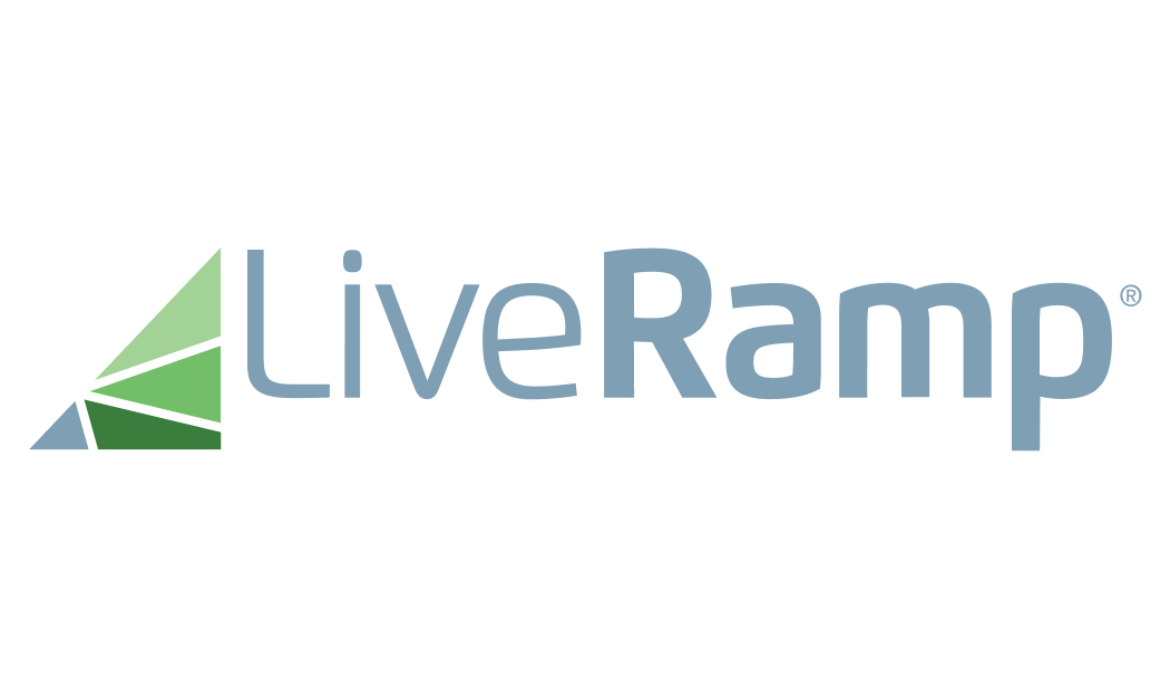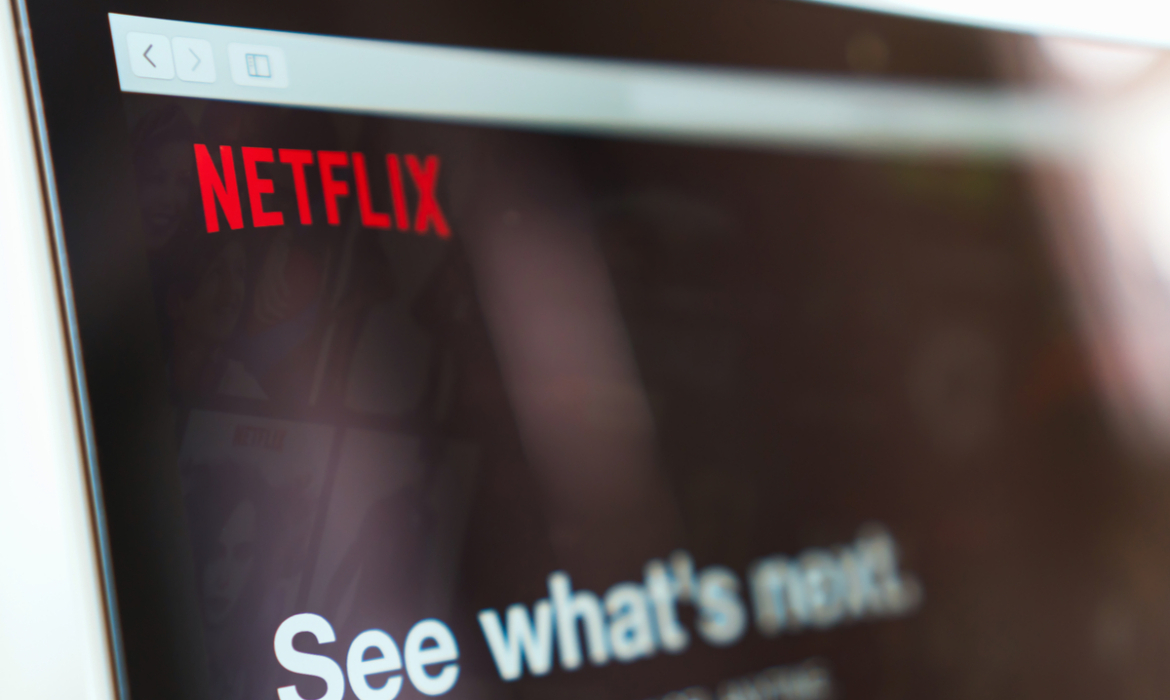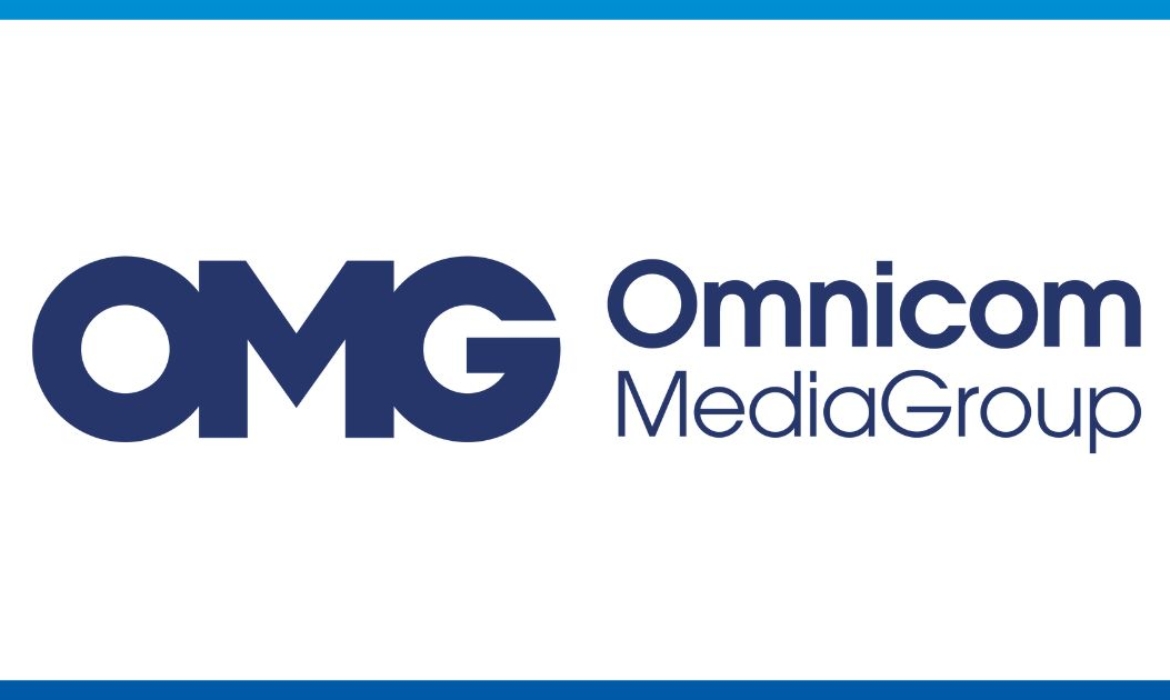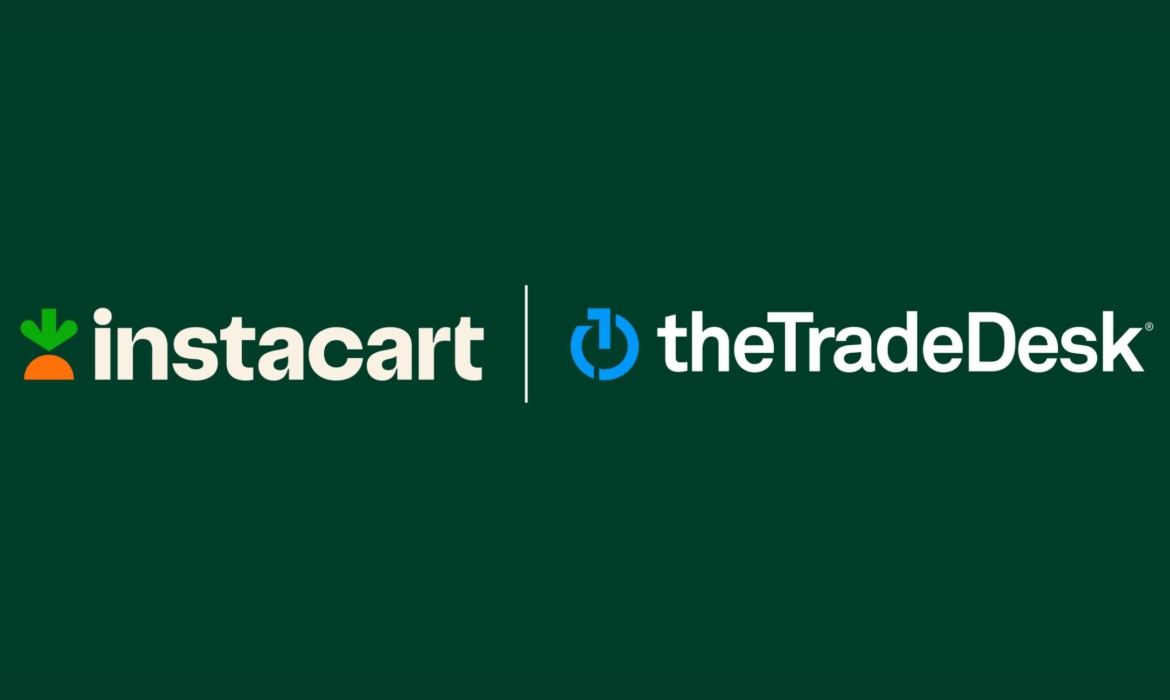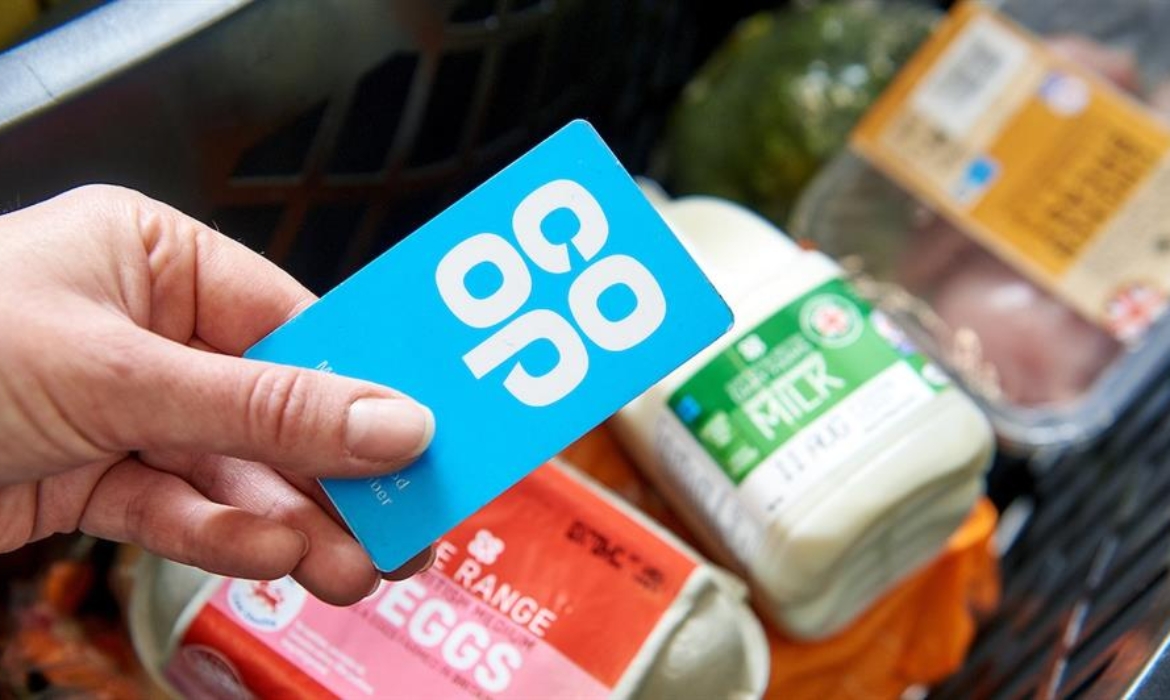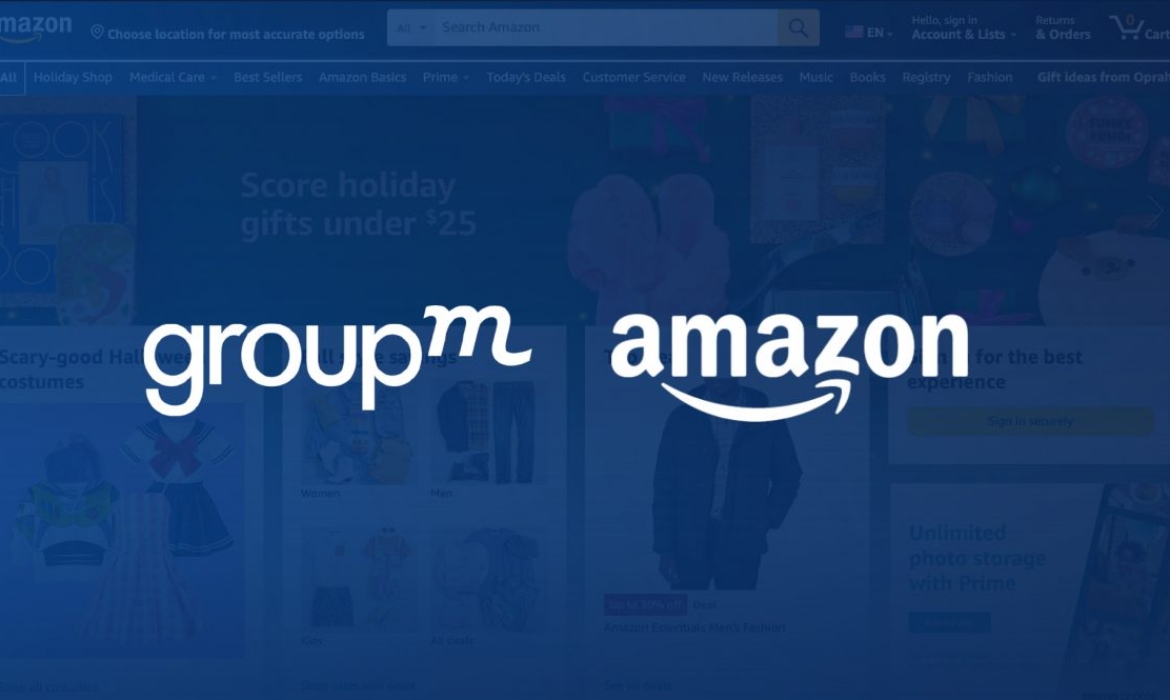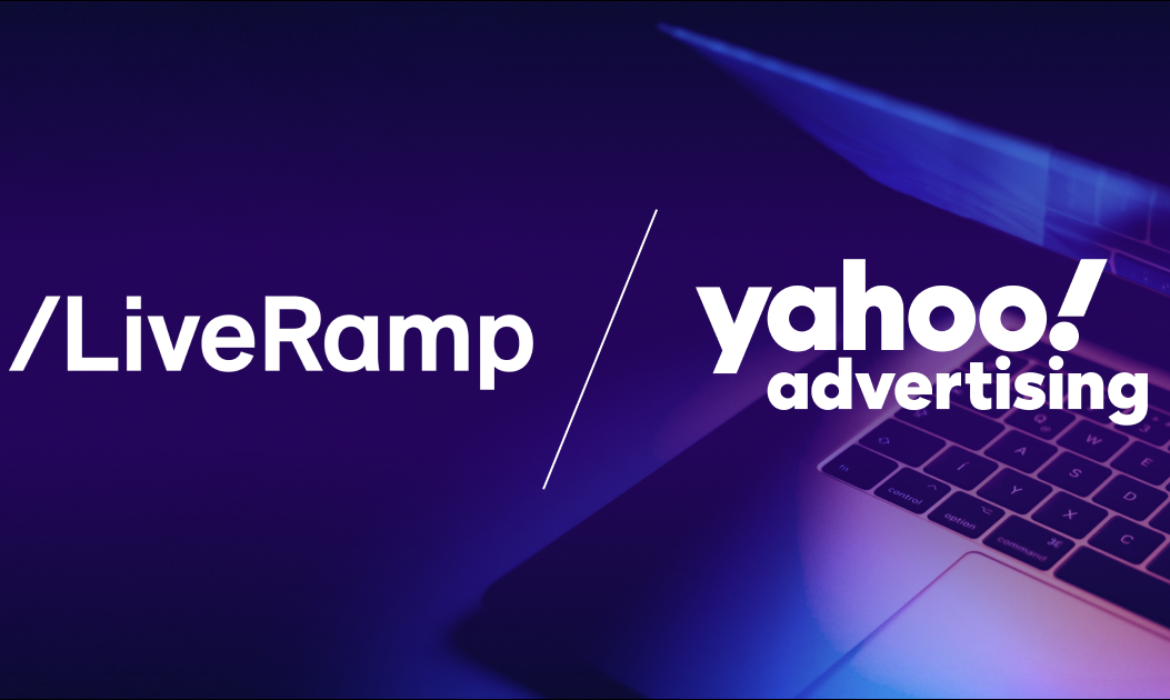AlgoriX and LiveRamp Turbocharge Cookie-less Digital Advertising
A diverse alliance between AlgoriX and LiveRamp aims to speed up cookieless transactions for the digital advertising industry. AlgoriX will integrate LiveRamp’s Authenticated Traffic Solution. Furthermore, it will allow its demand-side platform (DSP) and supply-side platform (SSP) users worldwide to transact on LiveRamp’s RampID.
AlgoriX integrates LiveRamp’s RampID to enhance digital advertising
Via LiveRamp’s data cooperation platform, over 450 of the top advertisers in the world initiate campaigns on RampID. With AlgoriX, LiveRamp’s solutions can now be connected internationally with over 165 DSPs and SSPs, allowing for large-scale reach of high-value audiences and the delivery of tailored experiences across browsers, mobile devices, and CTV. To further improve the AlgoriX SDK’s offering for developers hoping to boost their business in the mobile and in-app advertising arena, AlgoriX will also integrate LiveRamp’s Authenticated Traffic Solution SDK. With the help of AlgoriX’s SDK, these developers can now swiftly implement LiveRamp’s Authenticated Traffic Solution, improving inventory monetization and enhancing the addressability of their opted-in app users.
Read More: Yahoo and LiveRamp Expand Partnership, Scaling Addressability
Here’s what they said
Frederic Liow, AlgoriX SVP for revenue growth & strategy said,
As advertisers look to address signal loss on mobile, authenticated inventory offers a powerful solution that can deliver results for publishers and marketers that often surpass what they were generating with cookies and mobile device IDs. LiveRamp has helped lead the market in advancing authenticated identity as a viable alternative to help the ecosystem prepare for a post-signal loss future, and integrating our solutions will provide a powerful boost to our customers and developers.
Travis Clinger, SVP, of activations and addressability, LiveRamp added,
Consumers in APAC are mobile-first, which made it a natural fit to partner with AlgoriX given their history as a leader in the region and in the mobile app space. LiveRamp has proven it can drive results for mobile developers, and as the market experiences more signal loss, with these new partnerships there’s no excuse for stakeholders to delay benefitting from the superior results authenticated identity can drive.
Read More: LiveRamp Partners with Co-Op to Enhance Retail Media
Launch Cart Debuts AI-Powered Ad Platform LaunchADS.AI
Launch Cart, a pioneer in e-commerce solutions officially launched an innovative AI-driven advertising platform called LaunchADS.AI. Businesses can easily build and launch advertising across key platforms thanks to this innovative solution. These include LinkedIn, Meta, Instagram, TikTok, Google, and YouTube. LaunchADS.AI intends to improve how businesses interact with their target audience and enhance their advertising campaigns by incorporating OpenAI’s ChatGPT technology. It will make use of improving the creation of ad text, guaranteeing excellent and compelling material without the need for ongoing expert scrutiny, and making them available to companies of all sizes.
How will LaunchADS.AI benefit businesses?
An important development in the world of digital advertising is the release of LaunchADS.AI. Businesses now have new chances to contact and engage their target customers because of the power of artificial intelligence and Launch Cart’s e-commerce experience. LaunchADS.AI gives companies the option to instantly enhance their advertising campaigns by utilizing AI’s capabilities. To provide useful insights for making wise decisions, the program analyses a tremendous quantity of data, including customer behavior and advertising performance measurements. LaunchAD.AI also includes a machine learning system that continuously picks up new information from user interactions and feedback, enhancing the accuracy and efficacy of the generated ad content over time. By using an adaptive strategy, companies can continuously offer high-performing advertising that boosts conversions and earnings.
Read More: Hivestack Partners with Up Media to Expand Thai DOOH Market Share
Key features of LaunchADS.AI
- AI-powered ad creation: creates hundreds of catchy headlines and campaign-specific descriptions.
- Platform integration: Integrates with popular platforms including Google, Facebook, LinkedIn, Instagram, and TikTok, and is controlled from a single dashboard.
- Ease of use: Simple UI and user-friendly features make it simple for beginners to launch campaigns.
- Automated ad execution: Core automation guarantees quick ad launches, enabling campaigns to go live in record time.
- Unified Experience: A single login allows users to manage adverts on several platforms in a unified experience.
- Comprehensive Monitoring: ensures that businesses maintain control by offering real-time data and monitoring for ads across all platforms.
Additionally integrated with Launch CRM, LaunchADS.AI offers cutting-edge capabilities for customer relationship management. Businesses gain access to a complete suite with the Launch Cart eCommerce platform that combines advertising, CRM, and online shopping.
About Launch Cart
Launch Cart is a leading on-demand eCommerce system that offers cutting-edge technologies to improve online shopping for companies of all sizes. Launch Leads, for intelligent lead generation, LaunchADS.AI, for AI-driven ad design and targeting, and Launch CRM, for sophisticated customer relationship management, are all included in the platform. These solutions put businesses at the top of the cutthroat eCommerce market by allowing them to streamline operations, boost engagement, and increase conversions.
Read More: Chinese AI Firm Baidu Debuts ERNIE 4.0 Chatbot Competing with GPT-4
Netflix Striving to Expand Ad-Supported Format Reach and Appeal
Netflix is admitting that it still has ways to go in order to scale the necessary advertising reach and subscriber size with its ad-supported model. It claims that by taking a customer-focused approach and providing advanced features to advertisers, they may ultimately surpass competitor streaming services in the advertising market. Netflix suggests that its ad-supported tier serves as a backup plan for users who express dissatisfaction with price increases. It seems that the streaming behemoth believes its competitors are doing advertising incorrectly. Some of its streaming competitors haven’t yet done as well in creating an advertisement-friendly environment.
Netflix wants to educate consumers about the ad-supported tier
According to Netflix, part of its mission is to inform customers about what to expect from their Netflix advertisements. This allows people to consider what, given their unique tastes, would be the best decision for them. The secret is to use the data collected as more people use the ad-supported tier to build models and capabilities that minimize repetition and intrusiveness while delivering relevant ads and a tailored experience.
Insights on new subscribers to ad-supported plans
Some reports state that new customers to the ad-supported plans see four minutes or less of advertising every hour, whilst those who cancel and re-up only view 60 seconds or less. This is before the amount of ad time is progressively increased once more. Resulting in rumors that a sophisticated method of desensitizing ad-verse consumers is part of Netflix’s educational process. However, since last May, six months after the plan’s introduction, when the business claimed to have drawn close to 5 million sign-ups worldwide, Netflix has not made available the precise number of with-ad members. According to reports from July, out of over 75 million Netflix members in the United States, 1.5 million of them were using the advertising plan.
Read More: Meta Contemplates Ad-Free Subscriptions, Targeting Indian Market
Netflix’s Ad Formats Expansion
Netflix announced the start of title sponsorships for seasons, series, and new domestic live sports events in addition to the growth of its ad formats. It includes the addition of a binge format, as part of its effort to realize that potential. Apart from introducing ad buys for its top 10 content selection, Netflix is collaborating with Microsoft, an ad tech partner, to provide other programmatic ways to access its ad inventory. Future expanded targeting capabilities should be available soon, as improving ad relevance is the first stage.
Challenges Netflix Might Face
Customers who use streaming services aren’t used to any kind of advertisement environment. In the past, cord-cutters sought to save money by forgoing the pricey cable bundle. In the process, they improved their viewing experience by being able to watch content whenever they wanted, without interruptions. Priorities are ranked highest for measurement. Therefore, Netflix is working to give comparable measurement capabilities to service a large list of partners across other nations in addition to launching a measurement relationship with Nielsen in the U.S.
A chance for Netflix
Just one year into their agreement, Netflix started a restructuring of its advertising partnership with Microsoft in July. In order to revitalize the developing area of its business, the streaming juggernaut decided to lower its ad pricing. Netflix leaders within the firm voiced their displeasure with Microsoft’s ad inventory and sales performance. Microsoft was forced to make the maximum amount stipulated in the agreement reached more than a year ago. This was a result of weak sales and a smaller-than-expected ad market. Microsoft had been chosen by Netflix as a partner at the beginning of its advertising business.
Read More: Netflix Removes Password Sharing, What’s It Say For Subscribers?
Omnicom, NBCUniversal Pioneer Program-Level At-Scale Reporting
The media services branch of Omnicom Group INC, Omnicom Media Group (OMG), and NBCUniversal have partnered to provide program-level at-scale reporting for the network’s streaming platforms. This first-to-market capability makes use of NBCUniversal’s privacy-conscious clean room technology, NBCUnified Access (formerly known as Audience Insights Hub). It gives five advertisers visibility into where their ads are delivered and whether the content is consistent with their brand. Media buys for CTV do not yet have access to this information, which is crucial for spending decisions.
Omnicom Media Group’s call for new standards
OMG has made a request for additional guidelines pertaining to social, retail, programmatic, and CTV media. By using this capacity, NBCUniversal is meeting important objectives outlined in the CTV guidelines that OMG’s Council of Accountability and Standards in Advertising (CASA) released in 2021. The informal cooperation between OMG agencies, media partners, and clients proposed these new guidelines. It is dedicated to improving transparency and quality control for advertisers across social, SSP, retail, and CTV platforms. By partnering with top streaming companies like NBCUniversal, CASA is enabling capabilities that will increase category growth by improving the ROI and security of CTV as an investment for marketers.
What is CASA?
The goal of CASA is to empower buyers through the definition of key advertising rights and the advancement of the capabilities of corresponding media owners. This will improve buyer control, seller transparency, and brand safety for advertisers across expanding media channels. It also holds partners responsible, and this week’s release is the outcome of talks with CASA participants that lasted three years.
New proposed rubrics for at-scale reporting
CASA is driving breakthroughs in seller transparency and advertiser control across social, SSP, retail, and CTV channels, as highlighted in several OMG reports published during Advertising Week. A first set of rubrics covering the rights of advertisers and the remedies of social media companies covers social media advertising. According to OMG, the CASA program has collaborated with eight social media networks.
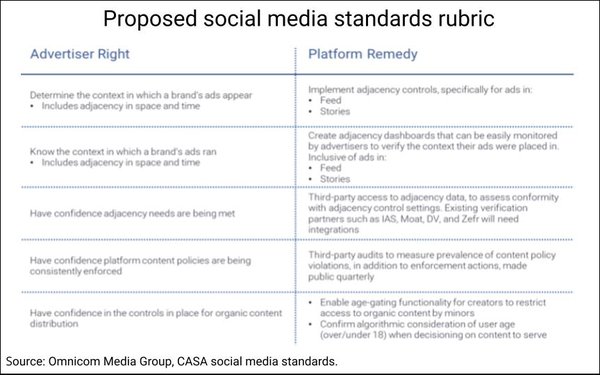
Image credit- Media Post
Read More: Omnicom and Criteo Unveil First-Of-Its-Kind Retail Insights Alliance
Additionally, OMG announced a proposed set of guidelines for supply side platforms (SSP) in programmatic advertising buys. OMG developed these guidelines in response to a recent analysis from the Association of National Advertisers. It detailed the $13 billion worth of “Made-for-Advertising” or MFA websites
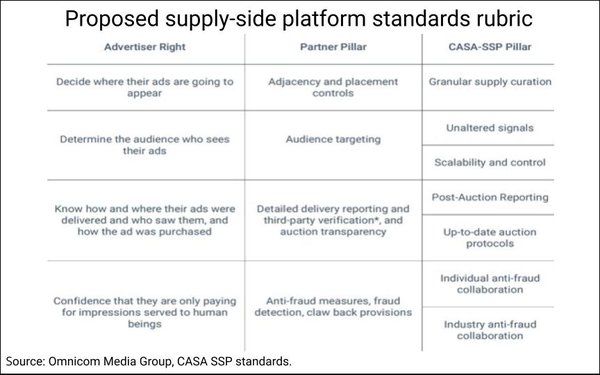
Image credit- Media Post
For retail media, OMG released a third set of suggested guidelines. They created it for addressing the meaningful ways that upper funnel channels like CTV can boost sales.
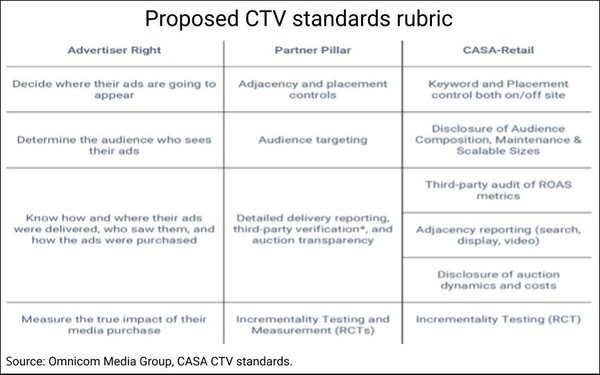
Image credit- Media Post
The CTV industry has received a fourth set of guidelines, and the council is now interacting with seven streaming networks and six OEMs/devices. 90% of all CTV is purchased programmatically through them. One or more pillars are fully activated at this point, and two or more pillars will activate soon.
Here’s what they said
Kelly Metz, OMG Managing Director for Advanced TV said,
Connected Television is rapidly becoming the primary channel for consuming long-form video, surpassing time spent watching traditional broadcast and cable television – yet its growth as an advertising medium has been hampered by its inability to provide the same level of control, transparency and safety for brands as its traditional counterparts. For that reason, NBCUniversal’s program level reporting capability is a game changer. Not only will it have transformative impact on planning and buying across NBCUniversal’s streaming properties – it also marks a watershed moment for the category by changing the CTV investment conversation from buying the audience for the platform to buying the audience for the content.
Dominick Vangeli, NBCUniversal SVP/General Manager for Advanced Advertising & Partnerships stated,
The future of streaming depends on media owners standing behind the value of their content. And at NBCUniversal we fully stand behind our content and believe that brand safety and quality are inextricably linked, which is why we are creating this new capability in partnership with OMG.
Read More: Paramount to Utilize iSpot As Currency Measurements for TV Ads
Instacart and The Trade Desk Partner To Boost CPG Advertising
The world leader in advertising technology, The Trade Desk, and North America’s top grocery technology company, Instacart, have announced a fresh collaboration. Through this collaboration, a limited number of CPG marketers will be able to leverage the strength of retail media in their programmatic campaigns. The alliance also hopes to increase the data-drivenness of CPG advertisers’ media buys on The Trade Desk. Based on customer activity and product purchase data from Instacart, it will allow them to connect with audiences that are interested in making a purchase.
Media buys for CPG advertising
GroupM and Beam Suntory are going to be pilot partners. With The Trade Desk, they will soon be able to develop and engage Instacart’s knowledgeable audiences for omnichannel advertising purchases. This data-driven strategy enables CPG brand partners to expand their reach outside of Instacart’s platform. Additionally, companies may reach highly motivated customers through The Trade Desk’s CTV and display channels before they even buy groceries.
Audience segmentation benefiting CPG marketers
Brands on The Trade Desk will have access to category-based purchase data from Instacart. They will be able to create more expansive, highly targeted audiences as a result, reflecting the purchasing habits of customers across the more than 1,400 retail banners that make up Instacart’s Marketplace in North America. Through the relationship, pilot brand partners can create audience segments based on categories. This can be achieved by layering their programmatic advertisements in The Trade Desk with exclusive Instacart data.
- Bought their category but not their brands
- Bought their brand
- Lapsed brand purchase
- Audiences who have never purchased their brand
Read More: New ‘Instacart for Shopify App’ Revolutionizes Merchant Advertising
Instacart – The Trade Desk Partnership
More than 5,500 brand partners on and off Instacart receive value from Instacart, which is dedicated to fostering growth and providing value. With the Trade Desk relationship, Instacart is demonstrating its ongoing commitment to supporting marketers’ off-platform solutions. To assist CPG clients in gauging the effect of streaming TV advertisements on e-commerce platforms, Instacart introduced the first set of off-platform measurement capabilities in April in partnership with a top manufacturer of CTV devices.
Here’s what they said
Ali Miller, VP of Ad Product at Instacart said,
Brands continue to tell us that they are looking for performant, data-driven solutions to maximize their return on investment. Instacart is attractive to marketers who want to drive results by reaching high-intent consumers, on a platform enhanced by our depth of consumer behavioral data and highly measurable outcomes. Now, we can help brands expand their reach to audiences off our Marketplace via our partnership with The Trade Desk. It’s critical for brands to reach consumers at scale, and ultimately drive purchase – and we’re excited to provide new solutions to help achieve those goals.
Ben Sylvan, Vice President, Data Partnerships, The Trade Desk added,
Instacart brings a wealth of valuable life stage and verified purchase data to our platform for CPG advertisers. Instacart-informed audiences will help The Trade Desk advertisers be a lot smarter with their media buying across the open internet, enabling them to reach their most valuable buyers. We’re excited to see how these advertisers can come up with new, innovative campaigns, especially on connected TV.
Brittney Duncan, Sr. Director NA Media & Digital Marketing, at Beam Suntory stated,
As a world leader in premium spirits, Beam Suntory is driving growth through quality craftsmanship, consumer connections and entrepreneurial spirit. Retail media is an important channel in our portfolio marketing mix and Instacart Ads continue to drive performance for our brands. Instacart’s new partnership with The Trade Desk provides an opportunity for us to scale our retail media efforts across our programmatic campaigns, and inspire even more like-minded customers to enjoy our premium spirits.
Lauren Lavin, Executive Director, Commerce, GroupM Nexus North America commented,
Over the last few years, retail media has emerged as a highly valuable lever for us to connect our clients with high-intent consumers directly at the point of purchase. GroupM continues to secure first-to-market opportunities, like Instacart’s new pilot partnership with The Trade Desk, so our CPG clients’ investments can work smarter across the complex media landscape we know today.
Read More: Instacart Enhances Ad Transparency and Trust with Strategic Alliances
Equativ Incorporates NinaData for Enhanced Contextual Targeting
Equativ, the top independent ad tech platform, has integrated with NinaData, a Finnish buying intent platform. Equativ’s Buyer Connect (EBC) digital ad curation platform now offers access to NinaData’s sophisticated contextual targeting and buying intent features. Additionally, it will make it possible for media buyers to successfully target the intended audience segments with appropriate ads at scale. Additionally, it won’t make use of first-party data or cookies.
NinaData’s Buying Intent platform
NinaData has unveiled the world’s best predictive buying intent tool for digital and programmatic advertisers. It makes use of the most recent generative AI technology to propel brands’ in-the-moment web outcomes. With NinaData’s LLM, purchase intent predictions will be delivered in place of text or picture solutions utilizing ChatGPT, and marketers will be shown precisely where these audiences may be reached.
NinaData – Equativ Integration
The Buyer Connect platform from Equativ gives buyers a number of tools, such as real-time media planning, to manage their private marketplace transactions effectively. Advertisers looking for privacy-focused addressability solutions will have additional access thanks to the integration with NinaData’s generative AI-powered purchase intent capabilities. In a setting that prioritizes privacy above all else, this will assist marketers in reaching consumers at the precise moment they are making a purchasing decision.
Read More: ThinkAnalytics’ Contextual Advertising Solution Joins AWS Clean Rooms
Here’s what they said
Valtteri Pukander, CEO of NinaData said,
We’re thrilled to partner with Equativ and bring our contextual LLM targeting capabilities to the company’s platform – by leveraging our buying intent targeting alongside Equativ’s Buyer Connect platform, advertisers can automate and streamline the ad buying process at scale, saving time and resources. Equativ is highlighting its commitment to privacy-first solutions by integrating our contextual advertising platform that doesn’t require any first-party data or user consent to provide buying intent insights.
Matthew O’Reilly, senior director, of platform partnerships at Equativ commented,
By bringing together a portfolio of partners that offer industry-leading data solutions, such as NinaData, our Equativ Buyer Connect offers media buyers seamless access to a multitude of targeting options designed to meet the needs of today’s privacy-centric marketers. Together, we are delivering high-performing contextual ads that drive results for advertisers and publishers while protecting consumer privacy.
About NinaData
With its main office located in Helsinki, Finland, NinaData is the first industry-leading Generative AI system that enables meaningful and private interactions between programmatic advertising operators and advertisers. The technical expertise of the NinaData technology team is combined with a wealth of industry experience and a lengthy history of developing scalable, high-value, and high-performance architectures for AI analytics of media content. The management and data scientists of NinaData blend methodological expertise with real-world application knowledge. They have previously held positions as co-founders of prosperous businesses, AI engineers, AI business managers, and researchers in machine learning.
Read More: Equativ Partners with Utiq for Ethical Programmatic Marketing Practices
LiveRamp Partners with Co-Op to Enhance Retail Media
To improve its retail media offering, LiveRamp, the top data collaboration platform, announced an alliance with Co-op, one of the biggest consumer cooperatives in the United Kingdom. The collaboration will increase member and brand relevance. Moreover, it will make use of its extensive first-party member data to raise the level of complexity in paid digital advertising targeting. Additionally, more targeted advertising across its grocery insurance and fast-food delivery companies will benefit members. Therefore, by concentrating their advertising expenditure on customers who are more likely to interact with them, firms employing Co-op retail media would be able to reduce their media waste.
LiveRamp – Co-op partnership for advanced retail media advertising
The member-owned company will be in a better position to support its assortment of suppliers by giving them more chances to connect with Co-op shoppers who are interested in their brands through off-site retail media channels. As the second-most frequented grocery chain in the nation, Co-op has more than 2,400 convenience stores across the U.K. It is a fast-growing e-commerce operation and has a devoted following of customers. These suppliers will benefit from a decrease in media waste. Demand for retail media opportunities is increasing due to a multitude of issues, including the impending cookie apocalypse in 2023. The appeal of first-party data held by supermarkets, such as EPoS and loyalty data, which enables advertisers to be more targeted in their marketing activities, is likely to phase out third-party cookies in Google Chrome.
Read More: LiveRamp – Epsilon Pave Way for Privacy-Compliant Advertising
The Co-op’s recent retail media overhaul
The Co-op collaborated with 450 businesses and nearly 2,000 campaigns in 2022. Additionally, the company redesigned its membership program in April and claimed to save customers up to £300 annually using the program. Since then, weekly sign-ups have tripled, and it now has more than 4.8 million active users. Several companies, including Walmart, Carrefour, Danone, Kimberly-Clark, and Boots are among LiveRamp’s clients in the supermarket industry. The core of Co-op’s retail media offering will be rich first-party datasets, providing enormous opportunities for companies to spur growth and increase the effectiveness of their advertising expenditures. The retailer’s first priority is protecting the interests of Co-op members while exercising due diligence in data ethics and data privacy. LiveRamp’s data collaboration platform allows for privacy-conscious data sharing without revealing any personally identifiable information.
Here’s what they said
Kenyatte Nelson, chief membership & customer officer at Co-op, said,
At Co-op, we’re investing in our retail media business to ensure we’re connecting our members to the missions and categories they engage with and for our partner brands to have the insight they need to succeed in the omnichannel customer journey. With LiveRamp, we can manage everything in our own media sales house with easy activations and this new partnership will enable brands to deliver the best customer experience to Co-op members and customers, resulting in better campaign success.
Hugh Stevens, MD UK at LiveRamp added,
Co-op is a well-established and diverse business with massive potential to unlock in its first-party data. We’re delighted to be partnering with them as the business expands its retail media with privacy-focused data collaboration that everyone in the Co-op ecosystem will benefit from, helping brands to better understand their customers’ needs, market to them more effectively and truly understand the efficacy of their investment.
Read More: Yahoo and LiveRamp Expand Partnership, Scaling Addressability
Chinese AI Firm Baidu Debuts ERNIE 4.0 Chatbot Competing with GPT-4
Chinese AI firms are competing with ChatGPT for market share, and it has now created a chatbot that can compete with OpenAI’s GPT-4 model. Chinese search engine and AI company Baidu introduced a novel iteration of its artificial intelligence model ERNIE 4.0. It asserts that the ERNIE 4.0 chatbot competes with American models like GPT-4. ERNIE 4.0 was demonstrated by Robin Li, CEO of Baidu, at the yearly Baidu World Conference in Beijing. Additionally, he showed how ERNIE can now be used with Baidu Maps to do tasks using natural language searches.
What is the ERNIE 4.0 chatbot?
The ERNIE model’s most recent iteration is ERNIE 4.0. It stands for Enhance Representation through Knowledge Integration. It is a natural language processing (NLP) model that can comprehend difficult instructions and queries, use logic and knowledge, recall prior knowledge, and produce material and replies that are pertinent and coherent. ERNIE asserts to compete with GPT-4, a different model created by the American research company OpenAI. The main language of ERNIE 4.0 is Mandarin Chinese. It can’t yet process English inquiries at the same high level of sophistication.
The capabilities of the ERNIE 4.0 chatbot include understanding, reasoning, memory, and generation. Li instructed ERNIE 4.0 to produce promotional materials, such as posters and videos, during a live demonstration. Additionally, he instructed the chatbot to create a martial arts novel with characters that had a range of personalities.
ERNIE 4.0 chatbot integration
Baidu unveiled its ERNIE chatbot in March. It made the model accessible to the general public in August. Although ERNIE 4.0 is not yet accessible to the general public, some individuals have been invited to test it out. Technology has the power to change how some items function. Baidu intends to include ERNIE 4.0 in its cloud services, search engine, maps, and business tools. Instead of just returning a list of outcomes and links, the search engine will now generate tailored responses in response to user requests. Significant changes in rankings, traffic, and advertising may result from ERNIE’s integration across its whole product line. These adjustments’ precise timing and scope have not yet been determined. As a result, global marketers must stay current with the latest developments.
Read More: Baidu unveils ERNIE, the AI-powered chatbot to ChatGPT
AI chatbot development in China
Following the global success of OpenAI’s ChatGPT, a host of Chinese businesses are competing to develop AI models, with Baidu leading the pack. Beijing hopes to overtake the United States as the world leader in artificial intelligence by the year 2030. China recently attempted to regulate the generative AI sector, forcing businesses to conduct security checks and acquire approvals prior to making their products available to the public. Businesses that offer these AI services are also required to abide by government requests for technology and information.
Baidu’s rise in the generative AI industry
Originally founded as a search engine, Beijing-based Baidu has made significant investments in artificial intelligence during the last ten years, including in the development of driverless vehicles. To remain competitive, it has moved into generative AI more recently.
China’s competitive landscape
Meanwhile, in an effort to prevent the military in China from obtaining the same technology, the US has placed extensive export restrictions on AI processors, such as NVIDIA’s H100, which is essential for training and operating huge AI models.
Here’s what they said.
Robin Li, CEO of Baidu said,
Ernie is not inferior in any respect to GPT-4. Ernie 4.0 has achieved a full upgrade with drastically improved performance in understanding, generation, reasoning, and memory. These four core capabilities form the foundation of AI-native applications and have now unleashed unlimited opportunities for new innovations.
Read More: Saudi Arabia-UAE Join Global NVIDIA Chip Race Amid AI Scramble
GroupM and Amazon Ads Partner for Creator-Led Shoppable Format
GroupM, the media investment division of WPP launched a global partnership with Amazon Ads. As a result of the collaboration, Amazon’s clientele will have access to novel ad formats created for creator-led shoppable content. The partnership enables GroupM clients to use customized formats to promote creative content within the Amazon DSP and in Amazon-sponsored brand placements. The Goat Agency, the influencer marketing specialist that WPP obtained earlier in 2023 designed the initiative.
Bespoke Features of the creator-led shoppable content
Only GroupM clients can access the solution through Goat. With audiences on Amazon.com, the relationship enables advertisers to better generate commercial outcomes. Important characteristics of these unique bespoke formats include:
DSP Amplification Off-site
The Goat Agency’s exclusive creator ad format will be available throughout the Amazon DSP both onsite and offsite, linking content and advertising possibilities in retail media. It has been improved by Amazon’s extensive analytics.
Sponsored Brands Integration
Exclusive to GroupM and Goat customers, Sponsored Brands, an above-the-fold Amazon.com Ad placement, will now incorporate creator-led shoppable content created by The Goat Agency. The ad experience extends the path onsite with the same influencer-led content driving greater engagement and revenue for brands, complementing Amazon DSP off-site amplification.
Enhanced Programmatic Creative Optimization
The Goat Agency’s unique creative will be cyclically informed by insights from campaigns used with Amazon Ads to improve audience targeting. Clients will benefit from enhanced commercial results by matching creator content with the audiences most inclined to make purchases by genre of content across both display and video media. This is thanks to Goat’s experience and Amazon Ads Audience Targeting.
Inspiration for Brand Pages
By uploading creator material to Product Pages and Brand Stores, Amazon could potentially increase conversion rates and transform Brand Pages into destinations for consumer inspiration.
Read More: GroupM Nexus Launches Innovative Marketing Solutions in Malaysia
Here’s what they said
Samantha Bukowski, Global Head of Commerce, GroupM Nexus said,
The development of this new capability is an important step we’re taking to better connect the creativity and engagement of creator marketing with the scale and sophistication of GroupM Nexus’s commerce capabilities. We’re excited to continue this collaboration with Amazon to further integrate inspirational content in commerce advertising in ways that deliver value for clients and Amazon’s consumers.
Amy Armstrong, Director of Global Customer Development Amazon Ads added,
We are excited to see how GroupM leverages this new ability to deliver creator content directly in the shopping experience and the benefit it will have for our mutual customers. GroupM is a valued customer of Amazon Ads, and we look forward to collaborating with them on innovative projects like this in the future.
Dafydd Woodward, Global Chief Operating Officer, The Goat Agency stated,
Beyond our proprietary style of content, one of Goat’s most significant points of differentiation is the ability to deliver high-rigor performance and guaranteed outcomes to clients through creator marketing. Our collaboration with Amazon Ads is a natural fit that is already delivering performance improvements on client campaigns across multiple markets.
Nilam Atodaria, Global Product Director at The Goat Agency commented,
Teaming up with Amazon Ads creates valuable opportunities for clients looking to activate creator-led campaigns in a performance-centric way. This collaboration allows us to deliver greater value for our clients by deploying more engaging and intelligent campaigns that drive measurable business outcomes. This unique combination brings an alternative version of Social Commerce, one which puts consumers and their shopping habits at the heart of product development.
About The Goat Agency
The Goat Agency (Goat), a global award-winning agency has been a part of GroupM Nexus since 2023. It delivers specialist content to niche audiences at scale. The business collaborates with top companies to use influencers as a performance media channel to promote digital transformation and competitive advantage. Goat has worked with, kept, and scaled some of the most interesting companies in the world since 2015, delivering social media and influencer campaigns in over 70 countries and 28 languages. Presently, Goat employs more than 350 people who operate in 35 different local markets, disseminating influencer content through all media platforms, executing industry-leading awareness and consideration campaigns, and generating sales for customers.
Read More: GroupM and Criteo Pilot Omnichannel Commerce Boost in APAC
Yahoo and LiveRamp Expand Partnership, Scaling Addressability
Yahoo and LiveRamp, a top data cooperation platform that connects data from many platforms, including DSPs and DMPs, while focusing on identity resolution and data onboarding, have announced an expanded partnership. The collaboration will increase reach and interoperability throughout the advertising ecosystem while scaling addressability. Additionally, it will make addressable inventory more widely accessible. With the help of this partnership, publishers employing LiveRamp’s Authenticated Traffic Solution (ATS) will be able to benefit from Yahoo ConnectID‘s cookie-free identity solution and open up new addressable demand.
Brands can leverage Yahoo ConnectID for addressable inventory
Through Yahoo ConnectID, which gains from RampID and the enhanced scale of LiveRamp’s Authenticated Traffic Solution, brands who use the Yahoo DSP can expand their reach. 30,000 publishers have embraced Yahoo ConnectID, which has been connected to more than 30 of the largest industry data platforms. It is supported by direct consumer relationships with approximately 200 million authenticated users in the U.S. Additionally, it will make all Yahoo-owned-and-operated properties’ addressable inventory available across all channels. RampID and LiveRamp’s Authenticated Traffic Solution enable authenticated addressability across browsers, mobile devices, and CTV, at scale over hundreds of destinations, and power LiveRamp’s person-based approach to identity.
Read More: Yahoo Partners with Amplified Intelligence for Attention Measurement
Publishers benefits
Without requiring any additional configuration or resources for authorized viewers at scale, publishers and advertisers may profit from this relationship. Additionally, it will deliver personalized experiences wherever they matter. As Yahoo ConnectID will now be available as an identifier, publishers should anticipate experiencing improved monetization on their authenticated inventory via ATS. Additionally, through the Yahoo DSP, marketers seeking post-signal loss solutions will have greater access to authenticated customers across publishers who have embraced RampID and/or Yahoo ConnectID. Clients will be able to maintain data control, forge closer connections with their customers, and add value throughout the customer journey. More than 450 brands now use LiveRamp to customize consumer experiences using their first-party data.
Here’s what they said
Elizabeth Herbst-Brady, Chief Revenue Officer at Yahoo said,
We strongly believe in authenticated addressability, and this partnership enables greater reach that will endure beyond third-party signal loss. We’re making it easier for marketers and publishers to leverage these solutions and maximize results, while simultaneously supporting more seamless transactions across the open web.
Travis Clinger, SVP, Activations, and Addressability, LiveRamp commented,
Yahoo is a powerful advocate for authenticated identity, and the connectivity we’re partnering to enable across their DSP and Yahoo ConnectID will help make the post-signal world a better experience for marketers than the world of today. Marketers and publishers now have even more flexibility to engage, personalize, and measure their customer journey.
Read More: Yahoo Partners with VIOOH for prDOOH and Twilio for First-Party Ad Reach

